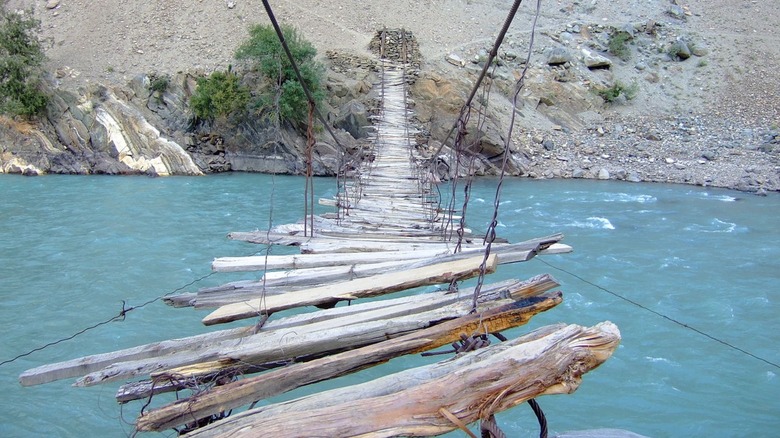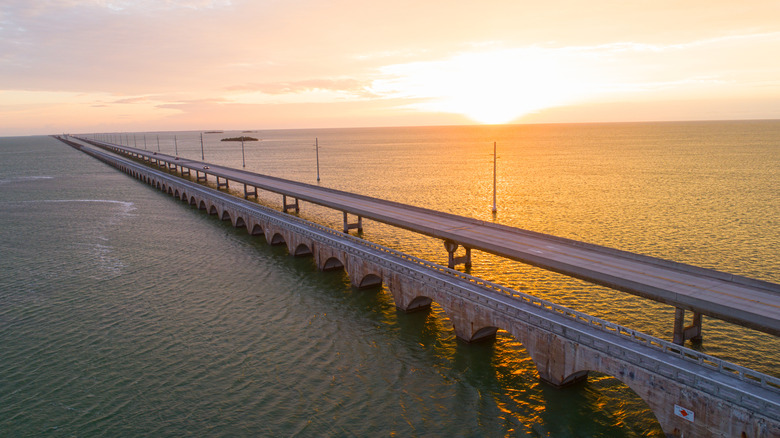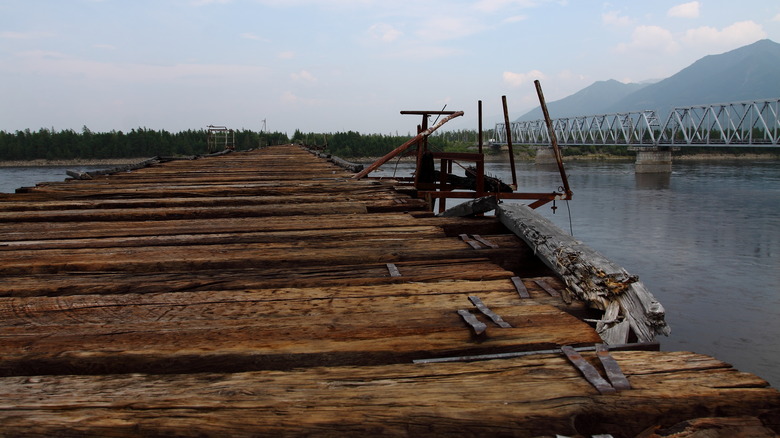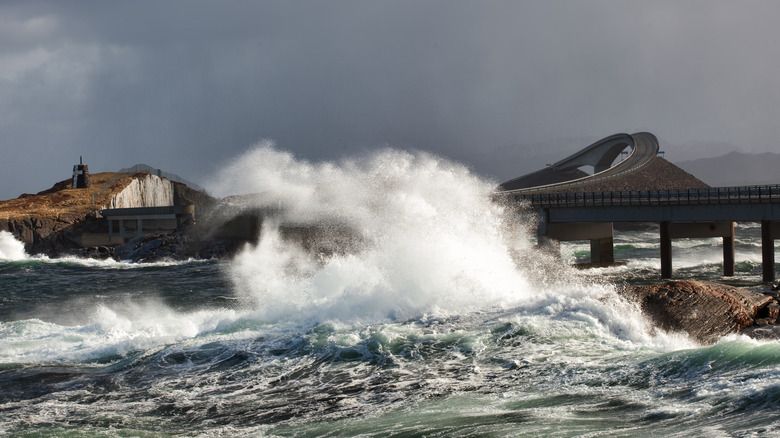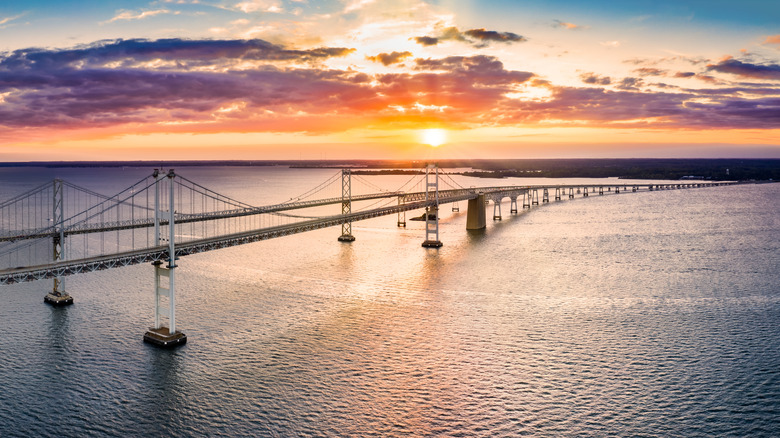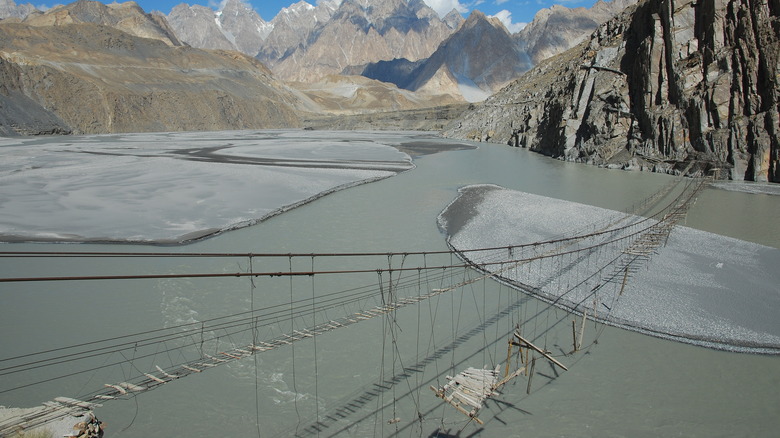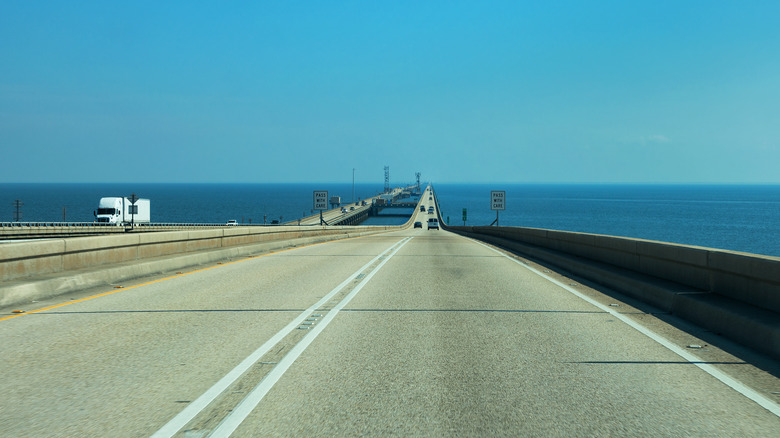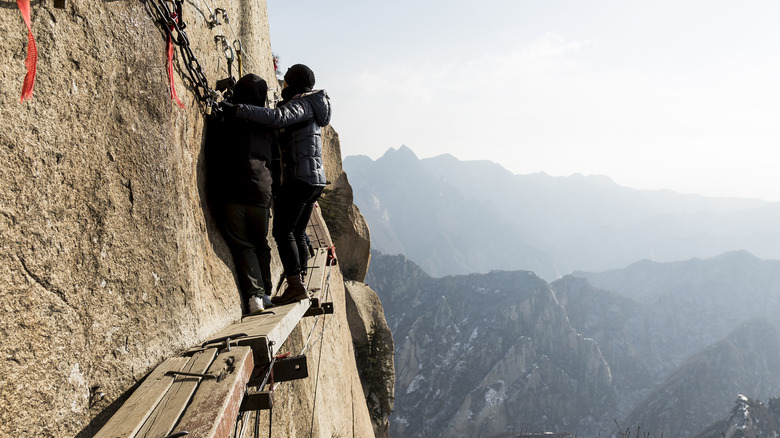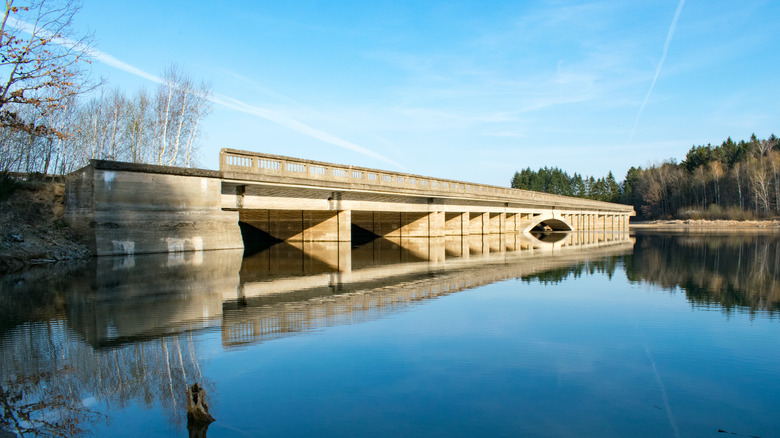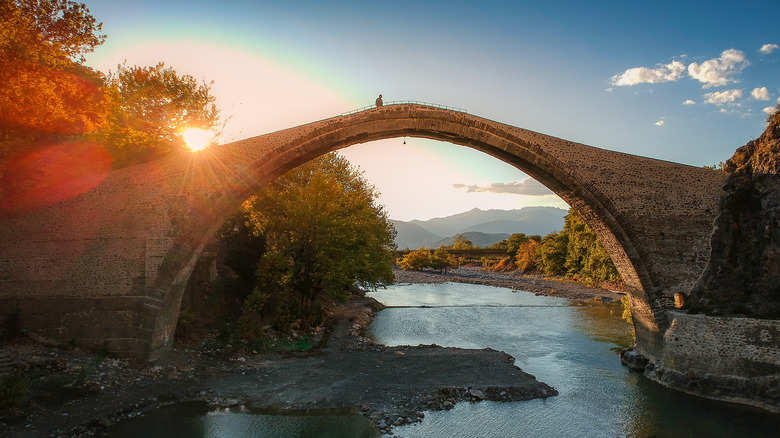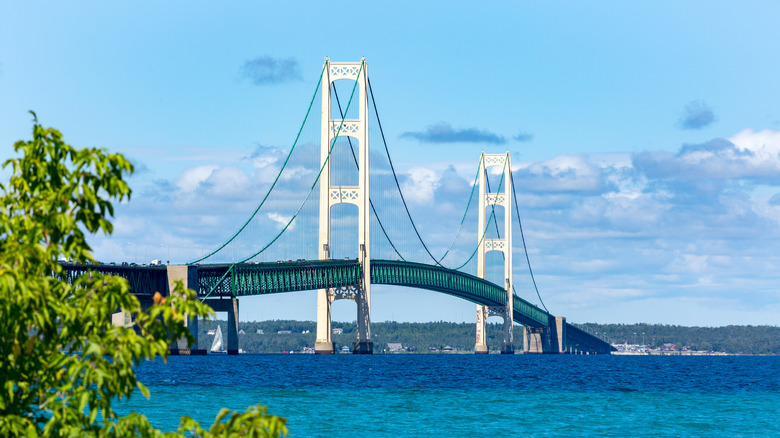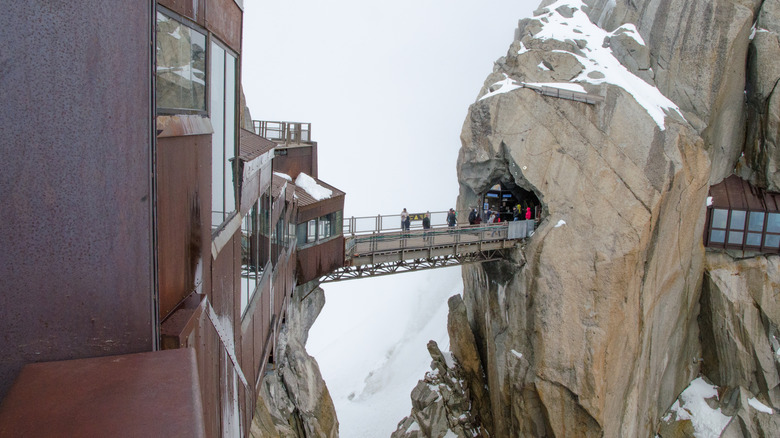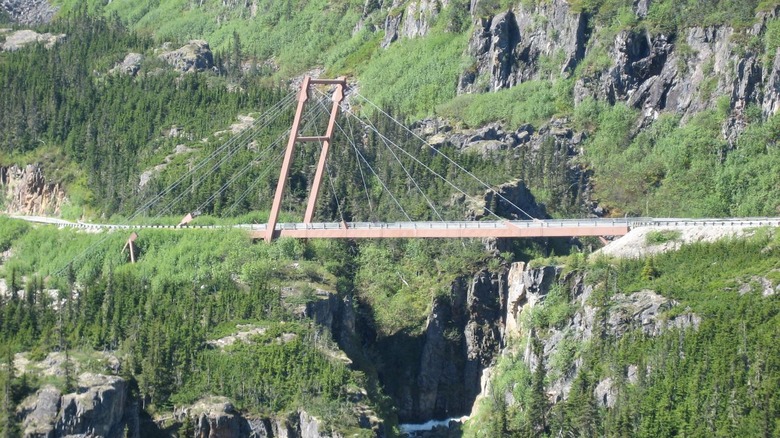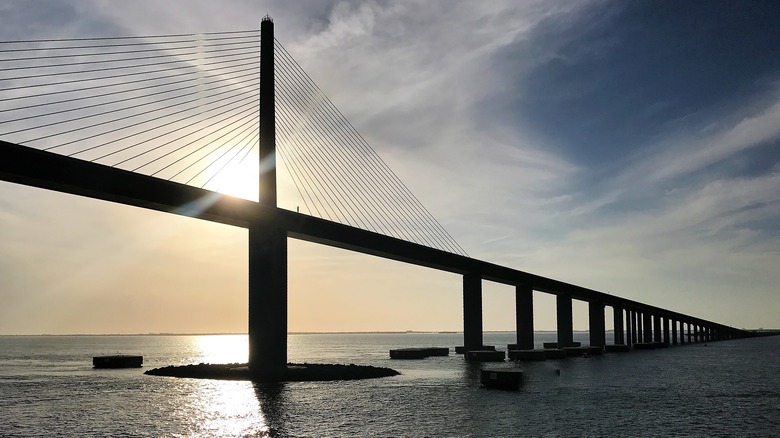The Most Dangerous Bridges In The World
If you've got a few extra minutes or are feeling particularly bored on the internet, here's a somewhat weird sounding suggestion of something to look up — bridges. Yeah, sure, it sounds a little dumb and really out of left field (and maybe just a little less flashy than, say, watching a movie) but seriously, there's some wacky stuff out there. Rope bridges suspended high over the forest, overpasses that seem to climb straight into the air, or natural bridges just made of vines in remote parts of the world. They're actually pretty neat to look at, and a good few of them seem terrifying.
But, as per usual, don't judge a book by its cover. The scariest bridges can be perfectly safe, and the most innocuous ones can be anything but. Sometimes it's bad planning, bad weather, degradation, or a mixture of those. Or sometimes it's something entirely different. Here are some of the most dangerous bridges in the world.
Accidents and storms on the Seven Mile Bridge
The Florida Keys sound like a beautiful place, right? Pristine blue water, clear skies, and the like? As it turns out, though, the area is actually also home to one of the most dangerous bridges in the world — the Seven Mile Bridge.
On one hand, it's just prone to a lot of accidents. According to Key West Injury Lawyer Blog, the bridge is especially narrow. The northbound and southbound lanes are squeezed right next to each other with no room or guardrail between them. So if everyone is paying attention, there's no problem. But if just one person makes a mistake, then you've got the makings of a head-on collision, and one that's impossible to avoid, because there's no room to pull off to the side, either. The choice is either running headlong into a collision or launching yourself off the bridge and into the bay. It's no surprise that the bridge has played host to thousands of car accidents in the last 40 years.
And to make things even worse, the bridge is regularly wracked by bad weather. In general, per NBC Miami, the Florida Keys regularly will see the appearance of waterspouts — tornadoes over water — fairly close to the bridge itself.
Icy conditions and the Vitim River Bridge
To be entirely honest, it's hard not to just look at a picture of the Vitim River Bridge and agree that, yeah, that thing would be really unsafe to cross. It's a case of "a picture is worth a thousand words," but there are still some words that are worth saying.
The Vitim River Bridge — or Kuandinsky Bridge — is located in Siberia, and it has a whole host of problems, as described by Dangerous Roads. To start with the obvious, there aren't any handrails, so any sort of slips or mistakes, and you're plunging into the icy cold waters of the rushing river below (or frozen river, depending). And mistakes are easy to make here. The bridge is only about 6-feet wide, just barely wide enough to actually fit a car, so you'd need steady hands not to veer off left or right at all.
Well, steady hands and a bit of luck. Because, this is Siberia, and the bridge is frozen over for most of the year, and the ice and snow definitely don't make travel any easier. Then that's still without mentioning the strong winds that frequent the area — or the rotting wood and missing planks.
Might be better off just finding another way around the river instead.
The Atlantic Ocean Road has unpredictable weather and bad storms
At first glance, the Atlantic Ocean Road just looks like a peaceful and scenic drive through a Norwegian archipelago. And, according to Dangerous Roads, in a lot of ways, it is. There are plenty of little scenic pit stops and viewpoints all along the way.
But the road has a much darker secret. It passes through a part of the sea that's known to be prone to especially violent storms and unpredictable weather. One minute, the weather might be perfectly sunny and beautiful, but the next, you might be suddenly hit with raging winds (sometimes over 30 miles an hour) or blizzards, which the area is well known for. Even without huge snowstorms, there's still the very real possibility that its twisting and turning lanes are sometimes hit by huge waves, covering the asphalt in sea water (via Slate), and some drivers reportedly fear that they might just fall into the ocean
Long story short — it's a beautiful drive, when you can see it. But sometimes the weather means you can see just about nothing, and driving the road becomes a test of your nerves.
The Chesapeake Bay Bridge's fog and violent winds
At first glance, it doesn't look like there's all that much wrong with the Chesapeake Bay Bridge. But, really, the truth is a little more hazy.
Per Dangerous Roads, this bridge is often the victim of some pretty intense weather. Fog is a fairly regular occurrence, and it can get bad. Bad enough that your visibility while driving just about goes down to zero, and it's effectively impossible to see the nearby shore by the time you're in the middle of the bridge. It's definitely a little nerve-wracking.
Really, though, strong winds are the bigger fear. The bridge is actually closed down entirely when the wind speed exceeds 55 mph (which is, frankly, just a pretty scary number to consider anyway), and during storms, officials drop the speed limit for cars crossing the bridge down to 35 mph (via The Virginian-Pilot). All the same, even with those safety precautions, multiple accidents have happened. CBS17 reported on a truck driver who went tumbling over the side of the bridge during a storm. Wind was cited as a possible reason for the accident, and for good reason. Another truck driver braved the same storm and told his terrifying tale of being battered left and right by the wind, convinced that if he'd taken his hands off the wheel for just a moment, he would've gone hurtling down into the waters below.
The Hussaini Hanging Bridge has a lot of gaps
Here's a bridge that, if you just give it a quick look, you're probably not about to think it's the safest thing to walk across. And you'd have good reason to think that. North Pakistan's Hussaini Hanging Bridge definitely raises a few eyebrows.
According to Orange Smile, the exact year that this bridge was constructed isn't known, but it was made as a way to cross through remote, and generally inaccessible, parts of the region (via Atlas Obscura). It's been around for a decent while, and its age — along with the fact that it sees minimal maintenance — really shows. The old bridge is just made of rope and planks of wood, with a good number of those planks breaking down over the years, leaving huge gaps between each of the steps that you'd really need to keep your eye on. And if that's not enough for you, icy winds frequent the area, shaking up the already unsteady bridge.
Really, weather has been a problem for this bridge in the past. If you take a look, just next to the bridge is another similar one that's completely destroyed, just a mess of dangling ropes and hanging wood.
All that said, technically, the bridge is structurally sound. So long as you're paying really careful attention, there shouldn't be any issues.
The Lake Pontchartrain Causeway is just really long
Louisiana's Lake Pontchartrain Causeway has a really special distinction — at almost 24-miles long, it holds the Guinness World Record for "longest bridge over water (continuous)," notes Atlas Obscura. And that's cool, but what actually makes it potentially dangerous?
Just the length, really, which has given rise to some bizarre situations. Basically, you've got 24 continuous miles over the lake. There are no pit stops of any kind. It's just water, and for about eight miles, you can't even see land, causing this bizarre feeling of being out at sea. And that freaks some people out, who end up freezing halfway through their drive (via Los Angeles Times). Police have had to escort people off the bridge, and they're also stationed all along the bridge to help fix car problems — flat tires and overheated engines, among others.
That said, medical emergencies are a whole different thing, and on multiple occasions, babies have actually been born in cars because the hospital was too far. And that's the point. This is over 20 miles of absolutely nothing, and if you were to encounter a serious problem, well, there just isn't much anyone can really do.
Oh, and because this is Louisiana, the bridge has also been hit by hurricanes. Not exactly a regular occurrence, but Hurricane Katrina actually broke down the bridge, while others have closed it completely (via NBC News and NOLA).
The Mount Huashan plank bridge puts you on the brink of death
Yes, true, most of the bridges on this list are over water, specifically, and the Mount Huashan plank bridge is most definitely not that. But, really, it was too hard not to mention. After all, it's a bunch of planks nailed to the side of a mountain. No matter the actual safety, it would definitely count as one of the most terrifying bridges.
According to China Discovery, the bridge itself is about 700 years old, built by a Taoist priest who carved stone nails into the cliff to support a bunch of wooden planks. The hike includes a relatively safe first section, a near-vertical middle section, and then the main event. The last section features no railing and a path that's only about a foot wide — at least, when you're not using stone holes as steps. Hikers are literally just on the edge of a long, long fall nearly a thousand feet down a vertical cliff face (via Travel China Guide).
That said, there have been regular renovations and safety measures, including safety ropes and harnesses, that make the walk safe enough for most tourists. Still, there are unconfirmed rumors of hundreds of people dying on this walk every year, and confirmed stories of some tourists falling due to unsecured ropes.
The Borovsko Bridge was never finished
If you were to take a little trip out to the Czech Republic and somehow managed to find yourself in the middle of a protected water reservoir, then you might end up stumbling upon the unfinished and abandoned Borovsko Bridge.
Dangerous Roads says that the bridge was initially started in the late 1930s, but construction suddenly stopped, leaving it mostly finished. In the end, the road it was meant to be attached to just never really came to fruition, and the bridge was completely abandoned and left leading to absolutely nowhere (unless you count the middle of the drinking water reservoir it now ends in). At this point, it's basically just been left to be constantly flooded, with the water nearly flowing onto the road itself.
Really, it's unlikely you'll actually be able to drive on this bridge — it and the surrounding area are off-limits — but even if you could, an abandoned, flooded, 1930s-era bridge doesn't seem like the safest place to be.
There's a lack of safety on the Konitsa Bridge
Rural, northwestern Greece seems to be absolutely beautiful — not just with its natural terrain but also some of the man made structures, especially one of the bridges.
The Konitsa Bridge, a stone pedestrian bridge crossing over the Aoos River, is really quite pretty, described as "charming" by Atlas Obscura, and has been standing for a little over 150 years. At first glance, there doesn't seem to be all that much of a problem.
Because it mostly just offers some potential problems. The bridge itself is pretty narrow, and the area it's located in can be prone to surprisingly strong winds — there's actually a bell hanging just underneath the bridge that serves as a warning for potentially dangerous conditions to cross in. So, yeah, the winds can be really bad. And that danger just gets compounded by the fact that, if you start looking more closely, there aren't really any notable handrails or walls, even at the very top, which stands almost 70 feet above the water. That means that, were you to be knocked sideways by a strong wind — or even a stumble — then there's not much to save you from a long fall.
High winds and speeding can cause death on the Mackinac Bridge
Suspension bridges have this quirk — they're pretty susceptible to wind. To be fair, they're made to deal with that. According to Dangerous Roads, a suspension bridge can shift and expand at certain joints to accommodate changing conditions, and that's definitely the case with Michigan's Mackinac Bridge.
But wind is still an issue nonetheless, and one that scares drivers. It's concerning enough, the Detroit Free Press reported that, in stormy enough conditions, taller vehicles — moving vans, trucks with campers, or even normal cars carrying things on their roof — would require escorts. They're literally in danger of being blown over by the wind — which can exceed 30 mph — and that's especially true if they're moving faster than about 20 mph.
That wisdom doesn't come from nowhere, because there are cases of trucks toppling over the side. The Detroit Free Press recounted a 1989 incident where Leslie Pluhar sped across the bridge, despite 48-mph winds. While her speeding was definitely a part of the problem, the winds caused her to lose control and get blown off the bridge to her death in the waters below.
The Aguille du Midi Bridge is really high up
To be completely honest, this bridge is a little different than most. It's not actually a super prominent bridge, and it's by all means perfectly structurally sound.
Here's the deal. As explained by Chamonix.Net, the Aiguille du Midi is a peak in the French Alps, and the highest one accessible by a lift system. The actual journey involves a long cable car ride, then a final elevator to the very top. But connecting those two steps is a footbridge, which sits around an elevation of 12,400 feet.
Again, the bridge is totally fine, but at that height, you might feel less fine. According to ScienceLine, around 8,000 feet, you can start to experience altitude sickness. There's less oxygen and a lot less pressure, so your body can't quite adjust to the weird changes, especially if you're used to living closer to sea level. And the symptoms aren't fun — shortness of breath, increased heart rate, and headache, to name a few. In really rare cases, altitude sickness can even lead to death.
Granted, for reference, Everest stands at 29,000 feet, so humans can definitely deal with higher altitudes than the footbridge on the Aguille du Midi, but it's still well above that 8,000-foot threshold for altitude sickness.
The Captain William Moore Bridge was constructed on an active fault line
Alaska's Captain William Moore Bridge is a pretty strange and interesting case. Built in 1976, the engineers working on the bridge knew exactly what sort of situation they were walking into. This bridge was going to be built over an active fault line (via Dangerous Roads). With that in mind, they did what they could to remedy the situation, namely, engineering a bridge that would only be attached at one side of the gorge that it spanned. Weird, right? They hoped that, should the ground at the fault shift, the bridge wouldn't shear in two.
Given that the bridge still exists, that seemed to have worked, but it eventually ran into other problems. CBC reported that the bridge just couldn't handle heavy loads anymore. It'd long been holding up lots of heavy trucks, some of them hauling ore, and that weight would make the bridge itself flex under the strain. The foundations were supposedly even starting to pull apart and weaken, which is concerning, all taken together. Luckily, to prevent disaster, plans went into place to retire the bridge and convert it to pedestrian use while constructing a newer, safer bridge.
The dark history of the Sunshine Skyway Bridge
Not all bridges are dangerous for the same reasons. Sure, there's weather or degradation, but Florida's Sunshine Skyway Bridge doesn't fully fit those. Yes, this bridge does have its share of physical dangers — a bad storm, a collapse, and dozens of deaths (via WUSF Public Media).
But, really, the bridge is most known as a hotspot for suicides. According to the Tampa Bay Times, it's among the worst in the nation (San Francisco's Golden Gate Bridge is up there, too). As of 2021, over 250 people have committed suicide from the bridge since 1987, with the yearly numbers trending upward over time.
All of those tragedies happened, even despite safety measures — phones on the bridge that connected to the local suicide hotline and regular patrols, both of which helped but didn't solve the problem. Calls for a higher wall or net went unanswered for years, due to a mixture of logistical and aesthetic issues, but luckily, early 2020 finally saw plans for the installation of a new barrier.
If you or anyone you know is considering suicide, please contact the National Suicide Prevention Lifeline at 800-273-8255.
